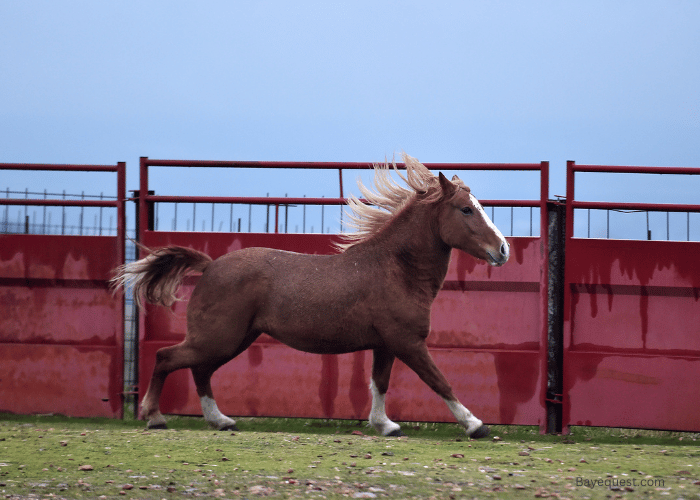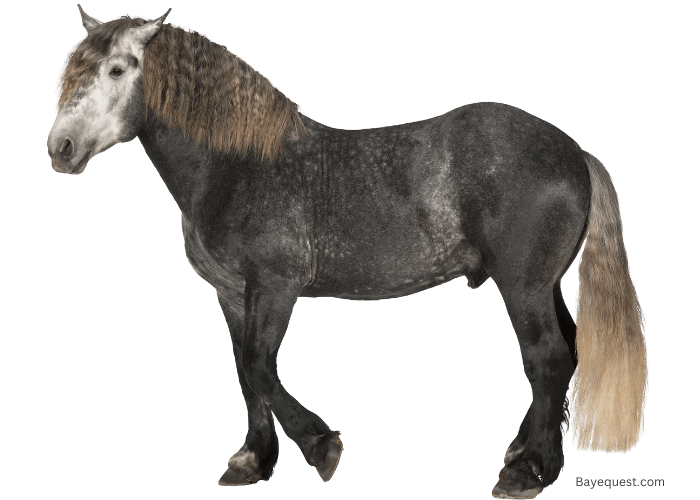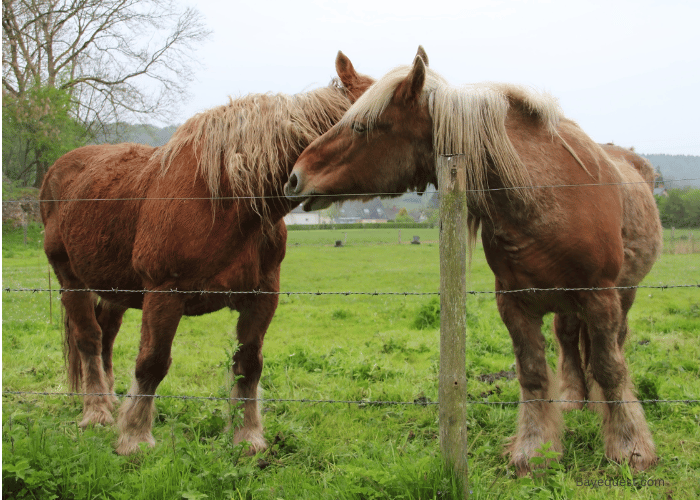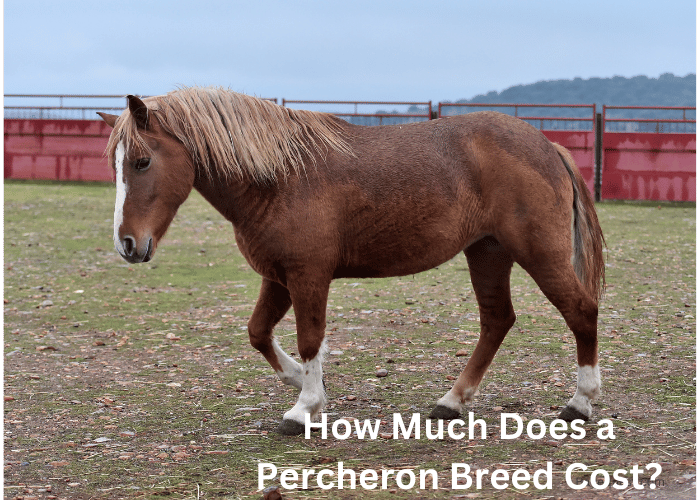Strong, stocky draft breeds are some of the most desirable horses. For centuries, they’ve simplified farm work and allowed traders to haul heavy loads easily. Above all, a strong horse was a major advantage on the battlefield.
But among them, none comes close to the Percheron horse. Americans and Europeans attribute most of their early success to this versatile equine.
Thankfully, you can still easily find Percherons in most states. Read on to learn about the going rates, upkeep costs, and the best places to find a friendly Percheron.
How Much Does a Percheron Horse Cost? Key Takeaway
Percheron horses cost $1,000 to $10,000, depending on the age, health, and pedigree. The average Perchron on a plantation costs $3,000 or less, with most farmers willing to sell older stock for as little as $1,000. However, a well-acclaimed gelding with a stellar show record costs $20,000 or more.
How Much Does a Percheron Breed Cost?
A mature Percheron horse costs $5,000, while the average price range is $1,000 to $10,000. However, the final price depends on the desired qualities.
Age is the first consideration when the seller sets the marked price. Younglings below one year are the cheapest, rarely costing above $2,000. You can even request a weanling between six and 12 months for under $1,000. But beware that weanlings need closer care until they mature.
Alternatively, consider an older horse if you’re on a budget. For instance, you can find a 20-year-old Percheron for under $3,000. But this age group also requires greater care, thus higher upkeep costs.
Stallions and mares between six and 15 years are the most expensive. Expect to pay at least $5,000 for equines in this age group.
Next, ask yourself why you need a horse. Are you looking for a pet for the kids? Or do you want a leisure horse to enjoy the evenings?
Alternatively, a sports person may need a horse for an upcoming event. It helps to match the budget to goals.
For example, pet horses don’t have to be expensive. Also, you can buy a young or much older horse for a pet. However, events have age-specific requirements.
So, occasionally, you may have to pay more to find the perfect equine. Also, some events have strict color requirements. Therefore, you must prepare to pay more.
The training also matters and may add several thousand to a Percheron’s price. Why? Because horse training is expensive.
Moreover, certain disciplines can earn future owners a windfall. Therefore, highly trained horses easily cost $10,000.

Breaking Down the Cost of a Percheron Horse
Unfortunately, bringing the horse home is only the start. Percheron ownership is a long, complex journey with many expenses. Let’s break down the most common expenses to help you plan for the whole ownership period.
Purchase Price
Purchase costs are the biggest upfront expense. On average, you’ll spend $5,000 to acquire a Percheron.
But depending on your needs, the final cost can be much lower or higher. Ultimately, most buyers spend $1,000 to $10,000 on Percheron horses.
Thankfully, there are several ways to reduce the purchase cost.
First, consider buying from local owners rather than breeders. For instance, an owner looking to trim their stock will happily sell mature Percherons for under $2,000. Many owners also happily let go of new foals for peanuts to keep maintenance costs down.
You can also find bargains in auctions. But professional opinion goes a long way when shopping at an auction as it can be a mixed market.
Boarding Costs
Horse boarding is a massive monthly expense, averaging $400 to $500. But again, savvy owners regularly find ways to bring down the costs.
Full-service boarding is the most expensive plan. Generally, the facility assumes all care duties, including farrier services and equine training.
They can even sign up your horse for equine shows. But it costs a staggering $600 to $2,000+ monthly.
Self-care and pasture boarding are viable alternatives if you’re on a tight budget. Self-boarding facilities provide shelter/housing while the owner handles regular care, including feeding, watering, and grooming.
Meanwhile, a pasture care facility provides feed, basic shelter, and water while the owner takes care of the rest.
Both are much cheaper than full-service boarding. Self-care programs cost $200 to $400 monthly in most states, while pasture care costs $400 to $600.
Feeding Costs
Percheron horses are big equines that consume tons of hay/forage and water daily. They also require substantial supplements to remain healthy and strong, so the feeding costs can be significant.
Ideally, consider foraging in the summer and hay in winter. This can save up to 60% of the costs. Otherwise, you need a $2,000+ feeding budget annually.
Hay alone costs $150 to $250 per month, given that horses consume 2% of their weight daily. Thus, a 2,100-pound horse requires 42 pounds of hay.
A 50-pound bale of hay costs $3-$10, depending on the quality and location. This comes to $2.52 to $8.4 daily, $75.6-$255 monthly, or up to $3,000 annually.
Salt and supplement costs and consumption rates vary widely, depending on the horse’s age, health, and lifestyle. But consider a $2/day budget at the least.
Read: Can Horses Have Watermelon?
Vet Care and Medical Bills
Percherons are hardy horses that don’t fall sick often. But you must plan for routine and emergency health care and farrier services.
Routine healthcare processes include vaccination, deworming, and dental services. The first two are fairly cheap. Unless you run into emergencies, they cost less than $200/year each.
Unfortunately, dental care isn’t as cheap. Vets charge $50-$70 per session for routine sessions and north of $300 for major procedures such as tooth removal.
Farrier service costs vary, too. The cheapest services cost under $50/month. But special shoeing can cost up to $300/month. Prepare for higher costs if the horse has foot injuries.
Finally, Percherons occasionally require emergency care due to reproductive problems, equine polysaccharide storage myopathy, and shivers. An emergency visit costs at least $250.
Accessories and equipment
Every horse requires a tack for handling. Fortunately, a basic horse tack comprising a saddle, stirrups, bridle, rein, halter, harness, and bits is affordable. You can find one on eBay for less than $200.
But a quality, long-lasting complete tack costs more. For instance, luxury saddles cost $600+. Moreover, you also need a helmet, boots, lunge line, and other items. Therefore, you may need $2,000 for the complete set.
Additionally, horse owners must have basic feeding and grooming equipment. Feeding equipment includes feeding pans, water buckets, and water heaters.
Meanwhile, grooming equipment includes curry combs, body brushes, fly repellents, shampoos, and cold weather blankets.
Consider reusing some of the equipment or buying second-hand. Otherwise, you’ll have an extra $2,000 in your budget waiting.
Additional Costs
Three other costs to remember when buying a horse are the training fees, insurance premiums, and registration/show expenses.
Training fees depend on the type of training and desired proficiency. Generally, you’ll pay $800 to $1,000 monthly for basic training.
Advanced training costs $1,200 to $2,500 per month. Specialized sessions cost up to $3,000 per month.
Insurance reimburses the owner for veterinary bills for covered conditions and procedures, such as bloodwork and ultrasound. But it costs $150 to $250 per year.
Finally, equine shows and events are optional but valuable. Unfortunately, they aren’t free.
For instance, it costs $150 to register a foal at the Percheron Horse Association of America (PHAOA). Meanwhile, most show and event registrations cost $50 to $150.

Percheron Horse Origin
The gentle giant is native to France. The foundation sire originated from the Husne River Valley in the French province of Le Perche.
Unfortunately, details of their exact origins are scanty. However, historians believe they are descendants of war horses.
The first Percherons arrived in the US in the 17th century as exports from France. Then, thousands more arrived on the US East Coast over the next century. Indeed, the Percheron once accounted for more than 70% of draught horses in the US.
The earliest owners used Percherons to pull carriages, wagons, and stagecoaches in towns and large cities.
Additionally, they were the go-to breed for hauling agricultural produce. The horses also provided valuable horse meat and later played a crucial role in the two world wars.
Characteristics of the Percheron
Percherons bear a great resemblance to the traditional draft horse. You may find smaller, shorter European mares.
But American Percherons are bigger. The average average weight of a horse ranges from 1,900 to 2,100 pounds. But bigger Percherons can reach 2,400 pounds.
It’s a majestic draft horse breed standing at 16.2 to 16.3 hands, though bigger stallions reach 17 hands to 17.2 hands tall. The horses boast a muscular build, with large shoulders, forearms, and haunches.
The legs are stocky and muscled. The same applies to the feet. The chest is wide, and the croup is broad.
The elongated, sturdy neck carries a small, clean-cut head with a massive mane. But, more importantly, the horse is proud and highly alert.
Percheron horses are mainly gray or black. Indeed, some states only recognize the two colors. Nevertheless, you can find them in many other colors, from bay to roan and chestnut.
But beware that excessive white markings on the head or legs may disqualify a Percheron from breed-specific shows and competitions.
Why Buy a Percheron Horse Breed?
Different people buy Percheron horses for different reasons. First, some Percherons are highly affordable. Although show legends cost tens of thousands, a regular Percheron is at most $3,000. Or you can get a weanling for under $1,000.
Others also prefer the Percheron for their unique beauty. For example, the gray Percheron is a unique and worthwhile option if you want to divest from the traditional bay horse. The blue roan Percheron is another masterpiece.
In addition, Percherons are strong cavalry horses, thus a good choice for demanding jobs. For example, plowing Percherons was a common sight in the 18th and 19th centuries. They also pull wagon carriages.
Incredibly, the Percheron is a calm-tempered horse that makes an exceptional pet. They’re also docile and highly trainable equines. Therefore, the best ones regularly compete and win in major equine events and contests.
Factors Affecting Percheron Horse Costs
The Percheron horse is a highly prized asset among owners and breeders. But that doesn’t mean you should pay over the odds. Consider the following factors to determine the true value of the horse before making an offer;
The bloodline: The horse’s ancestry is one of the biggest price factors. Traditionally, equines from a lineage of event and championship winners cost more. Closely scrutinize the records to confirm the lineage claims.
Show record: Percheron horses cost more if they’ve competed at and won in various equine shows. The price difference depends on the type of competition. Again, check the records to verify the claims.
Training type and level: Unbroken horses are generally affordable. But the prices jump a few thousand as soon as basic training begins. The type of discipline and level of proficiency are critical, too. For instance, dressage Percherons are expensive.
Others: Horse prices may also vary depending on the horse’s age, size (in hands), and weight (in pounds or kgs). Generally, bigger Percherons cost more.

Best Places to Buy a Percheron Horse
The three best places to find a Percheron for sale search are local owners and breeding centers, equine auctions, and online marketplaces.
Local owners and breeders
Do you know any local horse owners or breeding centers? Ask around if you don’t. They’re always looking to give away a few foals or older stock.
Alternatively, they’ll know someone selling their stock. Also, the prices are highly attractive.
Equine auctions
Many horse towns have weekly or monthly auctions where hundreds of equines exchange hands. The only downside is that auctions are complex markets that require experience.
Remember to bring a professional to help. Fortunately, auction prices are often friendly.
Online marketplaces
The proliferation of digital commerce allows buyers and sellers to easily meet and transact remotely.
Moreover, there are dozens of online platforms to consider, from Google to social media and company websites.
Best Percheron Horse Alternatives
The Clydesdale is the best alternative to the Percheron horse. They’re about the same size, with the Clydesdale just a little bigger.
Moreover, they are both strong workhorses that thrive on the farm and on the track. You may also be interested to know that Clydesdales and Percherons are in the same price range.
However, the Friesian is another option if the Clydesdale doesn’t excite you. Like Percherons, Frisians were developed from war horse stock. Thus, they are heavy and strong horses that excel in demanding environments.
However, the Percheron is stockier, while the Friesian horse has flashier knee action. More importantly, Friesian horses are expensive. The average stallion costs $25,000 to $30,000.
Finally, the quarter horse also makes a worthy alternative to Percherons. They are slightly shorter, with few health problems. But both breeds are robust and muscular.
Also, they’re bred for the same purpose – heavy work. Thankfully, Percherons and quarter horses are in the same price range.
FAQs
Are Percherons Bigger than Clydesdales?
No, Clydesdales are bigger than Percherons. Percherons are heavier. But Clydesdales are taller and bigger in overall size. They also have much larger feet and are characterized by heavier feathering. Meanwhile, Percherons have a more compact body, albeit bigger than the average horse.
Do Percherons Make Good Riding Horses?
Yes, the Perchron breed makes excellent riding horses. Their size is a turn-off for certain riders. However, they’re some of the best equines under saddle for riders who prefer larger horses. Their adaptability and willingness are unmatched. Moreover, you can ride them under English or Western saddles.
How Much Do Percheron Draught Horses Eat?
The average Percheron weighs 1,900 pounds, translating to 38 pounds of hay/day for a healthy, mature horse. However, they can weigh up to 2,400 pounds, translating to 48 pounds of hay/day. Additionally, mature Percherons require at least five pounds of grain daily plus vitamin and mineral supplements.
Is a Percheron Gelding Good for Beginners?
Yes, Percheron horses are perfect for beginners. They are docile, easygoing horses, always looking forward to the next ride. They are also sweet, tolerant horses that happily wait for learners relying on mounting blocks to get aboard. Percherons also tolerate beginner mistakes without throwing a hiss.
How Long Does a Percheron Draft Horse Live?
Percheron horses live for 25 to 30 years. This is slightly shorter than smaller horses. But it’s among the longest lifespans for draft horses. For instance, thoroughbred horses live for 25-28 years on average. Unsurprisingly, a few draft horses can live well past 30 with good care.
Summary
Percheron horses are among the hardest-working draft horses. They are also incredibly versatile equines, happy to toil on the farm and showing.
Thus, they can be expensive and even difficult to find. However, you can get a healthy, mature mare or stallion for $5,000 to $10,000. Meanwhile, foals cost $1,000 to $3,000.








